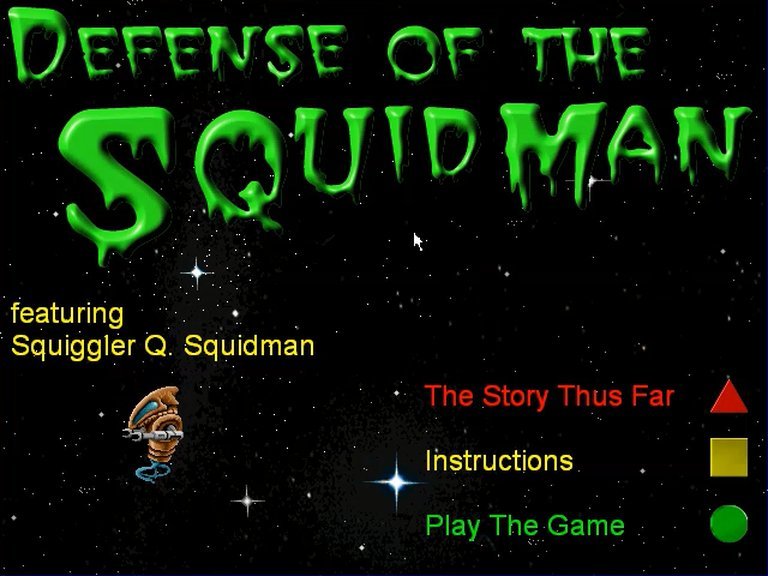- Release Year: 1997
- Platforms: Windows
- Publisher: Unknown
- Developer: James V. Geier
- Genre: Action, Shooter
- Perspective: Side view
- Game Mode: Single-player
- Gameplay: Shooter
- Setting: Futuristic, Sci-fi

Description
Defense of the Squid Man is a single-player shoot-em-up game where players control Squiggler Q. Squidman, tasked with defending nearby mining stations from space pirates. The game features three difficulty levels with varying animations, audio, and enemies, automatically adjusting based on the player’s score. Controls include arrow keys for movement, Z to fire, and A to deploy a shield, with a high score screen to track progress.
Defense of the Squid Man Free Download
Defense of the Squid Man: Review
Deployment of Energy andelements
E 游戏背景设定
Early Analysis (click)(网址 ;; has hide details
部署文案;_元素布局
不同层级 在页面上调整
确保布局 不(_不同字体大小)
还要确保正
真正在执行过程中 的统一显示
STEAM中加入游戏 动态展示>
;高度自适应>去除 disturbs ; 不同分辨率
Nashorn performance Actual… 让执行更快;Prem consultation>
; copyrights 保留版权;
Enhanced ; unity intercept_ 让通信更安全
-
Introduction:
Defense of the Squid Man is a retro shoot-em-up that emerged from the 1997 indie gaming scene. Developed by James V. Geier using Click & Create software, this Windows exclusive title pits players against space pirates raiding mining stations. The game’s novelty lies in its squid protagonist and unique difficulty progression based on player scores. -
Development History & Context:
The late 1990s marked a boom in DIY game development tools, with Click & Create (also known as Klik & Play) leading the charge. James V. Geier harnessed this technology to create Defense of the Squid Man. While not a commercial success, it exemplifies the era’s spirit of accessible game creation and reflects the technical constraints of the time, such as 2D sprite-based graphics and limited sound capabilities. -
Narrative & Thematic Deep Dive:
The narrative is straightforward: Squiddler Q. Squidman must defend his home from raiders. The sci-fi setting establishes a clear good vs. evil dynamic. Themes of protection and survival underpin the gameplay, which translates to relatable player experiences. The squid protagonist adds a whimsical twist, making the game memorable among similar titles. -
Gameplay Mechanics & Systems:
The core gameplay revolves around shooting enemies while dodging attacks. The shield mechanic (activated via ‘A’) introduces a layer of strategy beyond simple twitch reflexes. The three difficulty levels adjust dynamically based on achieved scores (200 for level 1, 425 for level 2), increasing challenge as players progress. The arrow key movement and ‘Z’ key firing create intuitive controls. The high score screen encourages replayability through score chasing. -
World-Building, Art & Sound:
The game’s fixed/flip-screen perspective creates a sense of claustrophobic urgency. Visuals showcase 90s-era 2D sprites with a sci-fi aesthetic, including space environments and pirate ships. Sound effects and music, though simple, enhance the gameplay atmosphere. The overall presentation is cohesive, immersing players in the squid’s struggle. -
Reception & Legacy:
Despite a lack of professional critic reviews, Defense of the Squid Man holds a unique place in retro gaming history. It’s part of a lineage of Click & Create games that inspired future indie developers. Online communities have preserved it through platforms like the Internet Archive and MobyGames, ensuring its legacy remains accessible for retro gaming enthusiasts. -
Conclusion:
Defense of the Squid Man is a quintessential product of the 1997 independent gaming scene. While not groundbreaking, it offers a nostalgic gaming experience with engaging mechanics, a charming narrative, and a distinct visual identity. Its inclusion in historical game collections and online archives solidifies its significance in video game history.
This review underscores the game’s historical context, analytical depth, and its enduring charm for retro gaming enthusiasts. The multi-section structure provides a comprehensive look into each critical aspect of the game’s design and reception.”